

A manufacturing floor where all machines adjust automatically to the slightest change, and staff can focus on innovation rather than routine checks. That’s the effect a powerful automation system can have!
Building a truly effective automation solution goes far beyond programming. It involves putting together the right technologies, smart decision-making, and intuitive design to maximize impact. The key components that make automation systems resilient, adaptable, and indispensable are:
1. Control Systems (The Brains Behind Automation)
Control systems serve as the core of any automation framework. These systems interpret input data, make real-time decisions, and adjust output devices to execute tasks based on programmed logic. Key control system components include:
- Programmable Logic Controllers (PLCs) are reliable. The primary controllers are designed to handle real-time processing and respond immediately to sensor data.
- In larger systems a more complex setup is required. Distributed Control Systems (DCS) can manage multiple subsystems.
- Supervisory Control and Data Acquisition (SCADA) systems provide a graphical interface. It gives operators visibility and allows them to manage remotely.
2. Sensors (Aiming Towards Capturing Data)
Sensors are the sensory organs of an automation system, capturing critical data that informs system adjustments. Without accurate data from sensors, the system cannot respond effectively to changes in its environment. Various types of sensors serve a specific purpose:
- Temperature and Humidity Sensors
- Pressure and Flow Sensors
- Occupancy and Motion Sensors
Accurate sensor data is vital to successful automation. It allows the system to respond quickly to changing conditions and maintain safety.
3. User Interfaces
User interfaces (UIs) provide operators with a way to monitor and manage the automation system. These interfaces range from physical control panels to sophisticated software applications and mobile dashboards.
Examples of user interface components include:
- Graphical User Interfaces (GUIs), often accessible from PCs or tablets.
- Touchscreens and Control Panels
- Mobile Apps
4. Output Control Devices
Once the control systems have made decisions, output devices translate these into physical actions. These devices directly interact with the machinery or equipment being controlled, executing commands such as adjusting valves, opening dampers, or switching motors on and off. Common output control devices include:
- Actuators are mechanisms that control valves, dampers, or other movable components
- Variable Frequency Drives (VFDs) control the speed of motors
- Relays and Contactors are electrically operated switches that manage high-power devices, ensuring on and off safely
5. Monitoring and Reporting (Real-Time Insights)
Monitoring and reporting are essential for assessing performance. Real-time monitoring provides visibility. Therefore, every step of the process it enables organizations to quickly identify bottlenecks, inefficiencies, and errors that may impact productivity.
This typically includes sensors, data loggers, and analytics software that collect and analyze information. Additionally, when dealing with any complex operation, rely upon aggregate metrics.
Conclusion
Creating an effective automation system depends on more than just technology. It demands a carefully orchestrated integration of hardware, software, and human input. Only by understanding and implementing these key components, can a business maximize the benefits of automation.
Visit (link) to understand while investing in the right components and ensuring seamless integration for your business.


